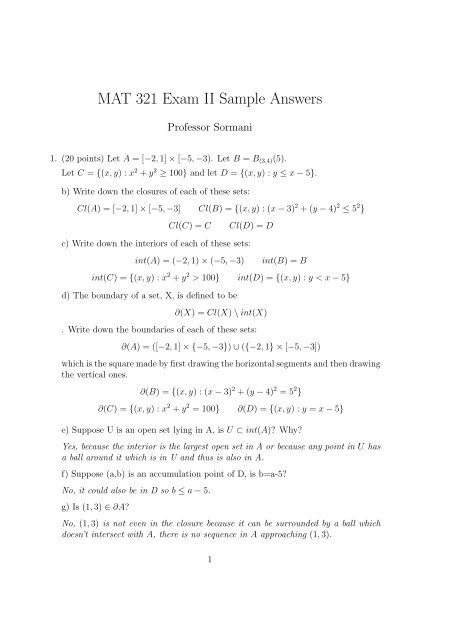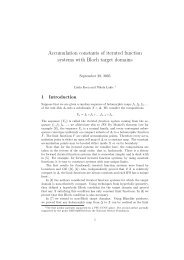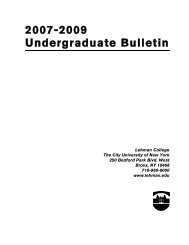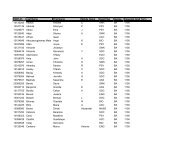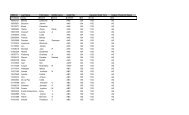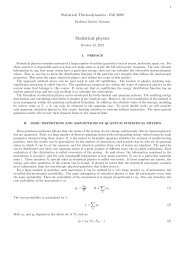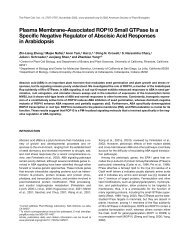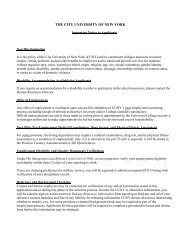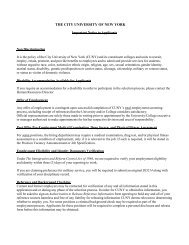Sample Exam Solutions
Sample Exam Solutions
Sample Exam Solutions
You also want an ePaper? Increase the reach of your titles
YUMPU automatically turns print PDFs into web optimized ePapers that Google loves.
MAT 321 <strong>Exam</strong> II <strong>Sample</strong> Answers<br />
Professor Sormani<br />
1. (20 points) Let A = [−2, 1] × [−5, −3). Let B = B (3,4) (5).<br />
Let C = {(x, y) : x 2 + y 2 ≥ 100} and let D = {(x, y) : y ≤ x − 5}.<br />
b) Write down the closures of each of these sets:<br />
Cl(A) = [−2, 1] × [−5, −3] Cl(B) = {(x, y) : (x − 3) 2 + (y − 4) 2 ≤ 5 2 }<br />
Cl(C) = C<br />
Cl(D) = D<br />
c) Write down the interiors of each of these sets:<br />
int(A) = (−2, 1) × (−5, −3)<br />
int(B) = B<br />
int(C) = {(x, y) : x 2 + y 2 > 100} int(D) = {(x, y) : y < x − 5}<br />
d) The boundary of a set, X, is defined to be<br />
∂(X) = Cl(X) \ int(X)<br />
. Write down the boundaries of each of these sets:<br />
∂(A) = ([−2, 1] × {−5, −3}) ∪ ({−2, 1} × [−5, −3])<br />
which is the square made by first drawing the horizontal segments and then drawing<br />
the vertical ones.<br />
∂(B) = {(x, y) : (x − 3) 2 + (y − 4) 2 = 5 2 }<br />
∂(C) = {(x, y) : x 2 + y 2 = 100} ∂(D) = {(x, y) : y = x − 5}<br />
e) Suppose U is an open set lying in A, is U ⊂ int(A)? Why?<br />
Yes, because the interior is the largest open set in A or because any point in U has<br />
a ball around it which is in U and thus is also in A.<br />
f) Suppose (a,b) is an accumulation point of D, is b=a-5?<br />
No, it could also be in D so b ≤ a − 5.<br />
g) Is (1, 3) ∈ ∂A?<br />
No, (1, 3) is not even in the closure because it can be surrounded by a ball which<br />
doesn’t intersect with A, there is no sequence in A approaching (1, 3).<br />
1
2. (20 pts) TRUE OR FALSE WITHOUT JUSTIFICATION<br />
a) If x ∈ int(A) then there is a radius r x > 0 such that B x (r x ) ⊂ A. TRUE<br />
b) If K is a compact set in C([0, 1]) then K is closed and bounded. TRUE<br />
c) If K ⊂ C([0, 1]) is closed and bounded then K is compact. FALSE<br />
d) If x ∈ Cl(A) then there is a sequence of points x k ∈ A such that lim k→∞ x k = x.<br />
TRUE<br />
e) If f : K → (−∞, ∞) and K is a compact set and f is continuous, then there<br />
exists a point x 0 ∈ K such that f(x 0 ) ≥ f(x) for all x ∈ K. TRUE<br />
f) If f : A → B is a continuous function between metric spaces and U is open in<br />
B then f −1 (U) is open in A. TRUE<br />
2
g) If x k is a sequence of points in an interval [0, 1], then at least one of the following<br />
is true:<br />
Case I: there exists a subsequence which lies in [0, 1/2]<br />
Case II: there is a subsequence which lies in [1/2, 1]<br />
TRUE (HEINE BOREL PROOF)<br />
h) f is a contraction mapping iff f is Lipschitz with Lipschitz constant < 1. FALSE<br />
(MUST ALSO CHECK DOMAIN=RANGE BUT DO NOT NEED TO CHECK<br />
ONTO)<br />
i) The functions f(x) = |x|, g(x) = x 3 and h(x) = √ x − 1 are all in C([0, 1]).<br />
FALSE, (CHECK DOMAINS)<br />
j) The tangent function whose domain is (−π/2, π/2) has a bounded range. FALSE<br />
(THE RANGE IS (−∞, ∞) which is not bounded)<br />
Other true false problems could concern the Contraction Mapping Principle, open<br />
covers and finite subcovers, converging subsequences, completeness and Cauchy<br />
sequences.<br />
3
3. (20 pts) Proof Formating<br />
Write the definition of the following statements using for all and there exists notation<br />
and then write the first few lines of proofs of the following statements which<br />
use those definitions. You do not have to fill in formulas for the values you are<br />
“choosing”.<br />
a) The set A = {(x, y) : y > x} is an open set.<br />
DEFN: ∀p ∈ A ∃r p > 0 such that B p (r p ) ⊂ A.<br />
1) Let p ∈ A<br />
2) Choose r p = − − − − − − − − −−.<br />
3) We claim: B p (r p ) ⊂ A.<br />
b) The function sin : [0, π] → [−1, 1] is continuous at π/2.<br />
DEFN: ∀ɛ > 0, ∃δ > 0 such that | sin(x) − 1| < ɛ whenever |x − π/2| < δ. (Note<br />
sin(π/2) = 1).<br />
1) Let ɛ > 0.<br />
2) Choose δ = − − − − − − − (actually δ = ɛ see below).<br />
3) We claim: |sin(x) − 1| < ɛ whenever |x − π/2| < δ.<br />
or equivalently, sin( (π/2 − δ, π/2 + δ) ) ⊂ (1 − ɛ, 1 + ɛ).<br />
If one were to continue with this proof, one can just do the following:<br />
∫ π/2<br />
∫ π/2<br />
|sin(x) − 1| = |sin(x) − sin(π/2)| ≤ | cos(x)dx| ≤ | 1dx| ≤ |π/2 − x|<br />
x<br />
x<br />
or use unit circle trigonometry relating arclength, x, to heights and so on.<br />
c) The set K ⊂ C([0, 1]) is compact.<br />
DEFN: Given any open cover, there is a finite subcover.<br />
1) Let ⋃ α U α ⊃ K.<br />
d) The set A = int(B).<br />
DEFN: A is the largest open set in B.<br />
REWRITE DEFN: All open sets in B, are contained in A and A is open.<br />
1) Let U be an open set in B<br />
2) We claim U is in A.<br />
Later one will also have to show A is open.<br />
4
e) Returning to (a), try an alternate proof beginning using a theorem about preimages<br />
of continuous functions as follows.<br />
State the theorem: the preimage of an open set is open.<br />
1) Let f : A = {(x, y) : y − x > 0} → (−∞, ∞) be the function f(x, y) = y − x<br />
2) The set f −1 ((0, ∞)) is an open set because it is the preimage of an open set<br />
and f is continuous.<br />
3) So A is open because: A = f −1 ((0, ∞)).<br />
5
4. (20 pts) Lipschitz Functions<br />
a) Prove the function f(x) = x 2 /10 where f : [−2, 3] → [0, 9/10] ⊂ [2, 3] is<br />
Lipschitz. Well,<br />
where<br />
∫ y<br />
|f(x) − f(y)| ≤ | f ′ (x)dx| ≤ |x − y|M<br />
x<br />
M = sup x∈[−2,3] |f ′ (x)| = sup x∈[−2,3] |x/5| = 3/5<br />
so f is Lipschitz with Lipschitz constant 3/5.<br />
b) Prove it is a contraction map.<br />
Since the domain is the range is [2,3], and the Lipschitz constant is 3/5 < 1 it is<br />
a contraction map.<br />
c) What does the Contraction Mapping Principle tell us? Starting at x 0 = 1 what<br />
is x 1 = f(x 0 ), x 2 = f(x 1 ) etc and where does it converge?<br />
It tells us that there is a unique fixed point x 0 ∈ [−2, 3] where f(x 0 ) = x 0 and that<br />
taking a sequence {x j } as defined here we will appraoch that fixed point. Starting at<br />
x 1 = 1, I get x 2 = x 2 1/10 = 1/10, x 3 = (1/10) 2 /10 = 1/1000 x 4 = (1/1000) 2 /10...<br />
which is converging to the fixed point x 0 = 0. This can be verified to be the fixed<br />
point since 0 = f(0).<br />
d) Is f Lipschitz as a function on the domain [0, ∞)?<br />
No, there is no single Lipschitz constant which works for all pairs of points x, y ∈<br />
[0, ∞). Taking x = 0 and y j = j we see that<br />
|f(x) − f(y j )| = |y 2 j /10| = j/10|y j | = j/10|y j − x|<br />
so there can be no Lipschitz constant that works for all j.<br />
e) Suppose x 0 = 100, what is x 1 = f(x 0 ) and the rest of this sequence? Does it<br />
converge?<br />
x 1 = (100) 2 /10 = 1000, x 2 = (1000) 2 /10 = 10000, x 3 = (100000) 2 /10... which we<br />
could prove to be a diverging sequence but won’t bother.<br />
f) Is f a contraction mapping from [0, 10] to [0, 10]?<br />
It does map [0, 10] to [0, 10] becauce f(0) = 0 and f(10) = 10 and it is increasing.<br />
But it has two fixed points, 0 and 10 so it cannot be a contraction mapping. Notice<br />
|f(0) − f(10)| = |0 − 10| so the Lipschitz constant is ≥ 1 not < 1.<br />
6
5. (20 pts) Proof<br />
Prove that if f : A → (−∞, ∞) is a continuous function and A is a compact set,<br />
then there exists a maximum point a 0 ∈ A such that f(a 0 ) ≥ f(a) for all a ∈ A.<br />
Fill in justifications:<br />
1) Let b 0 = sup(f(A)) which exists by continuoum property of the reals since<br />
f(A) ⊂ (−∞, ∞).<br />
2) There exists b i ∈ f(A) such that b i increase to b 0 by definition of sup of f(A).<br />
3) There exists a i ∈ A such that f(a i ) = b i by definition of image: b ∈ f(A) iff<br />
∃a ∈ A s.t. b = f(a).<br />
4) A subsequence of a i converge to some point in A by hypothesis that A is compact.<br />
5) Let a 0 be the limit of that subsequence.<br />
6) We claim a 0 is the maximum point:<br />
Complete the proof of the claim:<br />
6a) lim a i = a 0 ∈ A and f is continuous on A, so lim f(a i ) = f(a 0 ).<br />
6b) f(a i ) = b i by step 3, so lim b i = f(a 0 ).<br />
6c) By step 2 lim b i = sup(f(A)) so sup(f(A)) = f(a 0 ).<br />
6d) The sup is an upper bound for A by definition of sup. So<br />
f(a 0 ) ≥ f(a) ∀a ∈ A.<br />
Now prove there exists a minimum point:<br />
Imitate the above carefully upside down.<br />
7


